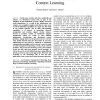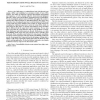611 search results - page 111 / 123 » Using GP to Model Contextual Human Behavior |
NIPS
2008
13 years 9 months ago
2008
Research in animal learning and behavioral neuroscience has distinguished between two forms of action control: a habit-based form, which relies on stored action values, and a goal...
CHI
2010
ACM
14 years 2 months ago
2010
ACM
Programming has recently become more common among ordinary end users of computer systems. We believe that these end-user programmers are not just coders but also designers, in tha...
ECAL
1995
Springer
13 years 11 months ago
1995
Springer
Neither `design' nor `evolutionary' approaches to building behavior-based robots feature a role for development in the genesis of behavioral organization. However, the n...
CORR
2004
Springer
13 years 7 months ago
2004
Springer
Social insect societies and more specifically ant colonies, are distributed systems that, in spite of the simplicity of their individuals, present a highly structured social organi...
TSMC
2010
13 years 2 months ago
2010
In a 2002 paper, we combined fuzzy logic with discrete-event systems (DESs) and established an automaton model of fuzzy DESs (FDESs). The model can effectively represent determinis...


